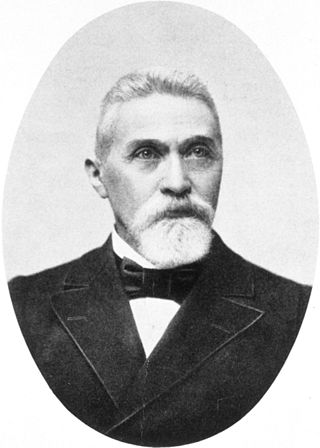
Ichthammol or ammonium bituminosulfonate is a medication derived from sulfur-rich oil shale. It is used as a treatment for different skin diseases, including eczema and psoriasis. It is applied on the skin as an ointments, most commonly containing 10% or 20% ichthammol.
Hans Christian Korting was a German dermatologist and medical researcher specializing in causes and treatment of infectious and non-infectious inflammatory skin diseases as well as non-melanoma skin cancer".
Laurent-Théodore Biett was a Swiss-born dermatologist from Schams in the canton of Graubünden. He is chiefly remembered for introducing into France an anatomical methodology of analyzing skin diseases; a system that was first developed by the British dermatologist Robert Willan (1757–1812).

Alfred Blaschko was a German dermatologist who was a native of Freienwalde an der Oder.
Erythema gyratum repens is a skin condition that has a strong association with internal cancers. It characteristically presents with red wavy lines, generally in older adults. These regular whirly rings rapidly and repetitively appear within existing ones, giving the impression that the rash is moving. The resulting pattern is similar to wood grain. There is often an intense itch and scale over the leading edge, which may be slightly raised.

Angioma serpiginosum is characterized by minute, copper-colored to bright red angiomatous puncta that have a tendency to become papular.

Eosinophilic cellulitis, also known as Wells' syndrome, is a skin disease that presents with painful, red, raised, and warm patches of skin. The rash comes on suddenly, lasts for a few weeks, and often repeatedly comes back. Scar formation does not typically occur.
Alan Lyell was a Scottish dermatologist who described Lyell's syndrome.

Figurate erythema is a form of erythema that presents in a ring or an arc shape. An example is erythema marginatum.
Torsten Zuberbier is a German dermatologist and allergologist.
Rheumatoid neutrophilic dermatitis, also known as rheumatoid neutrophilic dermatosis, is a cutaneous condition associated with rheumatoid arthritis.
Murata Kentarō was a Japanese dermatologist born in Iwaki, Fukushima. At 12, he went to Tokyo and studied philosophy until 1877. He entered the Tokyo University of Foreign Studies in 1874, where he studied German. He completed his medical training at Tokyo University in 1884 and in 1888 he went to Berlin on an exchange. Although he left due to illness, in Germany he studied under many prominent dermatologists, including: Georg Richard Lewin, Gustav Behrend, and Oskar Lassar at the University of Berlin; Mortiz Kaposi and Isidor Neumann at the University of Vienna in Austria. He also studied hygiene and pathology under Robert Koch, who became head of the University of Berlin in 1885.

Alexander Kapp is a German dermatologist and allergist. He was chairman and medical director of the department of dermatology and allergy at the Hannover Medical School until his retirement in 2022. He is known for his work in the field of pathophysiology of inflammatory skin diseases, his research on neuro-immunological interactions in allergic inflammation and on the role of eosinophilic granulocytes in allergy and dermatology.

Philipp Josef Pick was a dermatologist from the Austro-Hungarian Empire.
Johann Heinrich Rille was an Austrian dermatologist and venereologist.
Björn Dirk Krapohl is a German surgeon, specializing in plastic surgery and hand surgery at the University of Lübeck and the Charité in Berlin. He is known for his work in the fields of reconstructive microsurgery, hand surgery, and breast surgery.
Lajos Kemény is a Hungarian dermatologist, venereologist, allergologist, medical researcher, full professor and the Head of the Department of Dermatology and Allergology, the director of the Albert Szent-Györgyi Health Center, Faculty of Medicine, University of Szeged and the Vice-Rector for Science, Research Development and Innovation. He is a notable and respected scientist both in Hungary and around the world.
Günter Burg is a German dermatologist. Born in Mayen, Germany, he holds German and Swiss citizenship. He has been married to Dr. Doris Burg-Nicklas, a neurologist, since 1968. They have two sons: Andreas and Thomas.

Archives of Dermatological Research, published by Springer Science+Business Media, is a peer-reviewed medical journal that focuses on skin disease. It was established as the Archiv für Dermatologie und Syphilis in 1869 by Heinrich Auspitz and Philipp Josef Pick. Springer acquired the journal in 1921 and renamed it the Archiv für klinische und experimentelle Dermatologie und Syphilis. In the 1950s it followed the general trend to drop its link to sexually transmitted infections in its title. It became the Archiv für Dermatologische Forschung in 1971 before obtaining its current name in 1975.
Jadassohn's Handbook of Skin and Venereal Diseases, or Handbuch der Haut- und Geschlechtskrankheiten, is a medical textbook in the field of dermatology initially edited by Joseph Jadassohn between 1927 and 1933. It was later edited by Heinrich Adolf Gottron and G.W. Korting.









